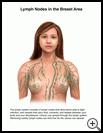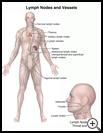
Lumpectomy
________________________________________________________________________
KEY POINTS
- A lumpectomy is surgery to remove a lump caused by cancer from your breast. You may also have lymph nodes removed to see if the cancer has spread.
- You may go home that day or stay in the hospital overnight. Ask your healthcare provider how and when you will get your test results.
- Ask your healthcare provider how long it will take to recover, if there are activities you should avoid, including how much weight you can lift, and when you can return to your normal activities.
________________________________________________________________________
What is a lumpectomy?
A lumpectomy is surgery to remove a lump caused by cancer from your breast. When the lump is removed from your breast, you may also have lymph nodes removed to see if the cancer has spread. This procedure is also called a partial mastectomy or breast conservation surgery.
Lymph nodes are normally the size of a pea and are found throughout your body. The lymph system consists of lymph nodes that store blood cells (lymphocytes) to fight infection and vessels that carry fluid, nutrients, and wastes between your body and your bloodstream. Many types of cancer spread through the lymph system. Removing nearby lymph nodes can limit how far the cancer can spread.
When is it used?
A lumpectomy is a treatment for breast cancer.
Ask your healthcare provider about your choices for treatment and the risks. Also, it is helpful to have a family member or friend listen to the choices with you.
How do I prepare for this procedure?
- Plan for your care and find someone to give you a ride home after the procedure.
- You may or may not need to take your regular medicines the day of the procedure. Tell your healthcare provider about all medicines and supplements that you take. Some products may increase your risk of side effects. Ask your healthcare provider if you need to avoid taking any medicine or supplements before the procedure.
- Tell your healthcare provider if you have any food, medicine, or other allergies such as latex.
- Follow any other instructions your healthcare provider gives you.
- Ask any questions you have before the procedure. You should understand what your healthcare provider is going to do.
What happens during the procedure?
You will be given general anesthesia to keep you from feeling pain during the procedure. General anesthesia relaxes your muscles and you will be asleep. The surgeon makes a small cut and removes the lump and surrounding breast tissue. You may have one of two procedures to remove lymph nodes:
- Sentinel lymph node biopsy (SLNB). If you have SLNB, a blue dye is injected around the area of the lump. The dye finds the first lymph nodes to which cancer cells are likely to spread from a tumor. Then a small cut is made in your armpit and the nodes containing the dye are removed. These nodes are checked for cancer.
- Axillary lymph node dissection (ALND). If you have ALND, the lymph nodes under your armpit are removed through another cut in the armpit. A drain will be left in the cut in your armpit for a few days.
What happens after the procedure?
You may go home that day or stay in the hospital overnight. Ask your healthcare provider:
- How and when you will get your test results
- How long it will take to recover
- If there are activities you should avoid, including how much weight you can lift and when you can return to your normal activities
- How to take care of yourself at home
- What symptoms or problems you should watch for and what to do if you have them
Make sure you know when you should come back for a checkup. It is helpful to have a family member or friend with you on the first visit after surgery, when you discuss test results.
- If no cancer is found in the lymph nodes and removal of the cancer is complete, your provider may still recommend chemotherapy or radiation therapy.
- If cancer is found in the lymph nodes, then you will usually be advised to schedule more surgery to remove the remaining lymph nodes in the armpit before you have chemotherapy or radiation therapy.
What are the risks of this procedure?
Every procedure or treatment has risks. Some possible risks of this procedure include:
- You may have problems with anesthesia.
- You may have infection, bleeding, or blood clots.
- Several days after surgery, fluid may cause swelling in the area where you had surgery. This usually happens after the drains have been removed. The fluid can be removed by your healthcare provider with a needle and syringe.
- You may have an allergic reaction to the dye used to find the sentinel lymph nodes.
- A lumpy scar, called a keloid, may develop. Tell your provider if you have other scars that have healed this way.
- After axillary lymph node dissection, the underside of your arm will probably be numb due to the loss of nerves to the skin.
- You may develop arm swelling, called lymphedema. Removal of the lymph nodes under your armpit can change the way the lymph fluid drains from the arm. Lymphedema can happen right after surgery or months to years later. A mild injury, such as from a blood test, a blood pressure cuff that is too tight, or an infection in the arm can cause lymphedema or make it worse. Ask your provider how you can help avoid this problem.
- Depending on the size of the lump that was taken out and the size of your breast, the shape of your breast may change.
- Your nipple may point another way and your breasts may not match as well as before the surgery.
- Lab tests may show that the cancer was not completely removed. If this happens, you may need more surgery.
- The cancer may come back.
Ask your healthcare provider how these risks apply to you. Be sure to discuss any other questions or concerns that you may have.
For more information, contact:
- National Cancer Institute
800-422-6237 (TTY: 800-332-8615)
https://www.cancer.gov/


